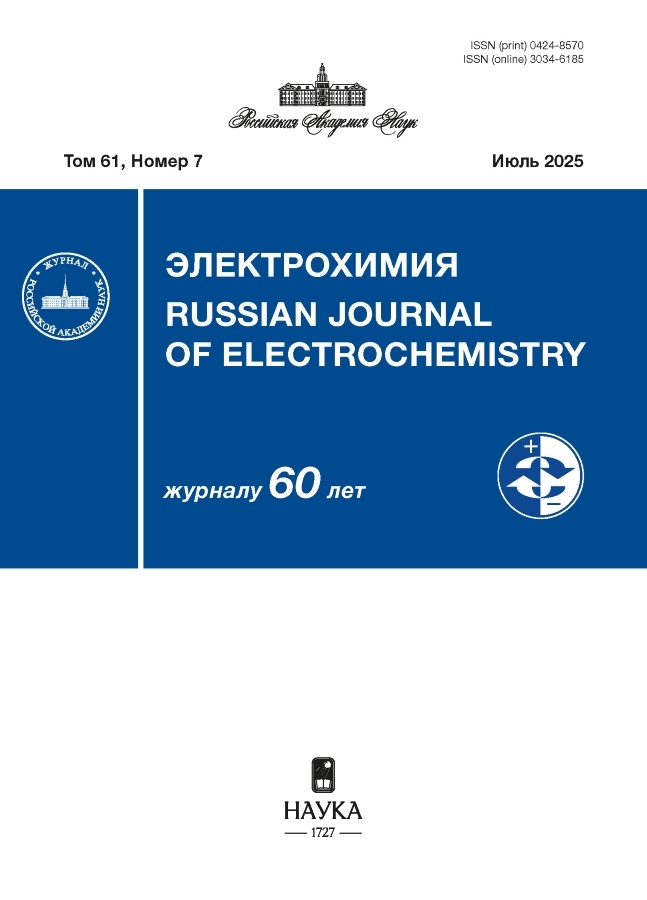Èlektrohimiâ
Russian Journal of Electrochemistry is an international journal covering all aspects of research in Pure and Applied Electrochemistry as well as in Electrochemical Materials Science.
Both original (full-size, short-communication and letter-to-editor types) and review manuscripts may be submitted in English or Russian by authors of any country(ies).
Media registration certificate: No. 0110270 dated 09.02.1993
Ағымдағы шығарылым
Том 61, № 7 (2025)
Articles
Modeling of electrochemical machining of cylindrical surface by partially insulated tool cathode
Аннотация
The electrochemical machining (ECM) of the outer surface of rotating cylindrical workpiece by a cylindrical cathode with a partially insulated surface is simulated. It is shown that partial insulation of the surface of tool electrode (TE) allows increasing the localization of the metal dissolution on the desired area of the workpiece surface. The degree of localization is greater, the smaller the non-insulated part of TE and the minimum interelectrode gap at which the machining proceeds. Partial insulation of the TE surface leads to a certain decrease in the ECM productivity; however, the edge effect at the boundary between the insulated and non-insulated parts of TE partially compensates for this drawback.
 313-327
313-327


Transport Characteristics of Perfluorinated Sulfocation Exchange Membrane with Respect to Vanadium (IV) and (V) Cations
Аннотация
Ion-exchange membrane in contact with acidic solution of vanadium salts represents an object of study by many research teams in the context of its indispensable presence as an element of membrane-electrode assemblies of both all-vanadium redox flow batteries and hybrid flow power sources which use vanadium compounds inside one of the half-cells. In this work, a new method has been employed for assessing the transport characteristics of the Nafion211 membrane with respect to vanadium ions of high oxidation degrees, i. e. vanadyl (VO2+) and vanadate (VO2+) cations, inside aqueous sulfuric acid solutions of varying acidities. The method is based on measuring chronoamperograms, i. e. current transients after a potential step of the electrode in contact with a membrane (pressed to its surface) under conditions where the current of the electrochemical conversion of vanadyl/vanadate at the electrode/membrane interface in the forward or backward direction is limited by the transport of these species across the membrane from an external solution. It has been found that the short-time segments of the transients can be described by the Cottrell dependence (I ~ t–0.5); both the Cottrell coefficients and the steady-state currents are proportional to the reagent concentration at the outer side of the membrane. Measurement of chronoamperograms as well as their interpretation to calculate both the diffusion coefficients of vanadyl and vanadate cations inside the membrane and their distribution coefficients at the membrane/solution boundary have been carried out for varying the sulfuric-acid concentration (from 2.2 M to 5 M) and the concentration ratio [VO2+]/[VO2+] from 0 to 1 inside the external solution. It has been found that the increase of acid content leads to the growth of vanadyl diffusion coefficient in membrane from 1.76 до 0.84·10–11 m2/s, and vanadate diffusion coefficient falls from 1.89 to 0.8·10–11 m2/s. Meanwhile, distribution coefficients decrease for both of them: from 0.27 to 0.13 and from 0.21 to 0.12 correspondingly. Conclusion has been made on the applicability of the method to analyze the ion transport and the equilibrium composition of ion-exchange membranes in contact with a mixed sulfuric-acid oxovanadium-cations solution.
 328-342
328-342


Composite Solid Electrolyte Na2SO4–Al2O3
Аннотация
The effect of adding nanosized γ-Al2O3 on the properties and structure of Na2SO4 was studied using differential scanning calorimetry, vibrational spectroscopy, electrochemical impedance spectroscopy and X-ray diffractometry. It was shown that the introduction of nanosized γ-Al2O3 into sodium sulfate leads to a significant increase in the specific ionic conductivity to 8.48 × 10–5 S/cm at a temperature of 603 K. The results of X-ray diffraction studies and vibrational spectroscopy confirm partial amorphization of the salt in the near-surface region of nanoparticles. The data obtained indicate that the sodium sulfate-based composite can be a promising ionic conductor for solid-state Na-ion batteries in the temperature range of 513–603 K.
 343-354
343-354











